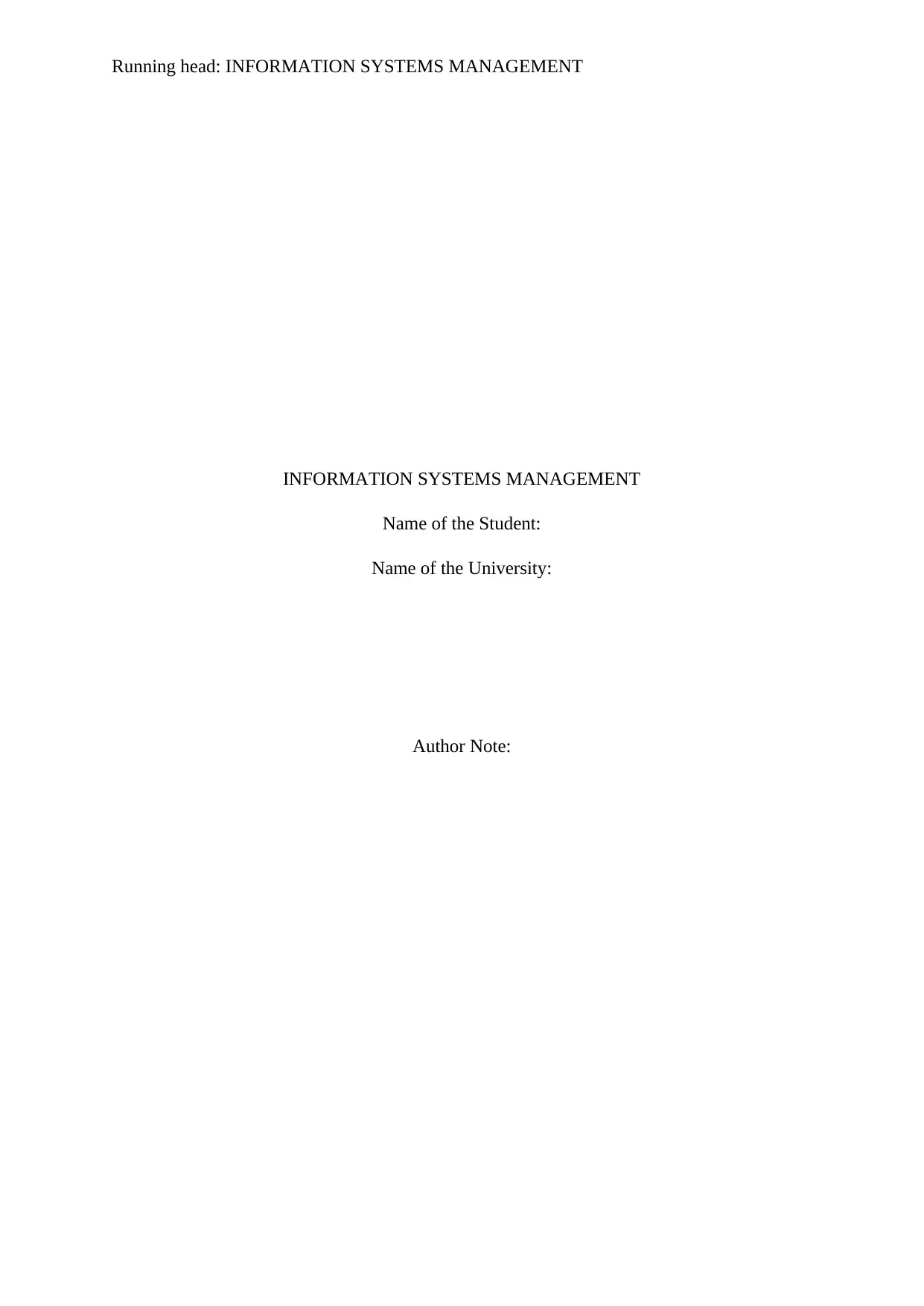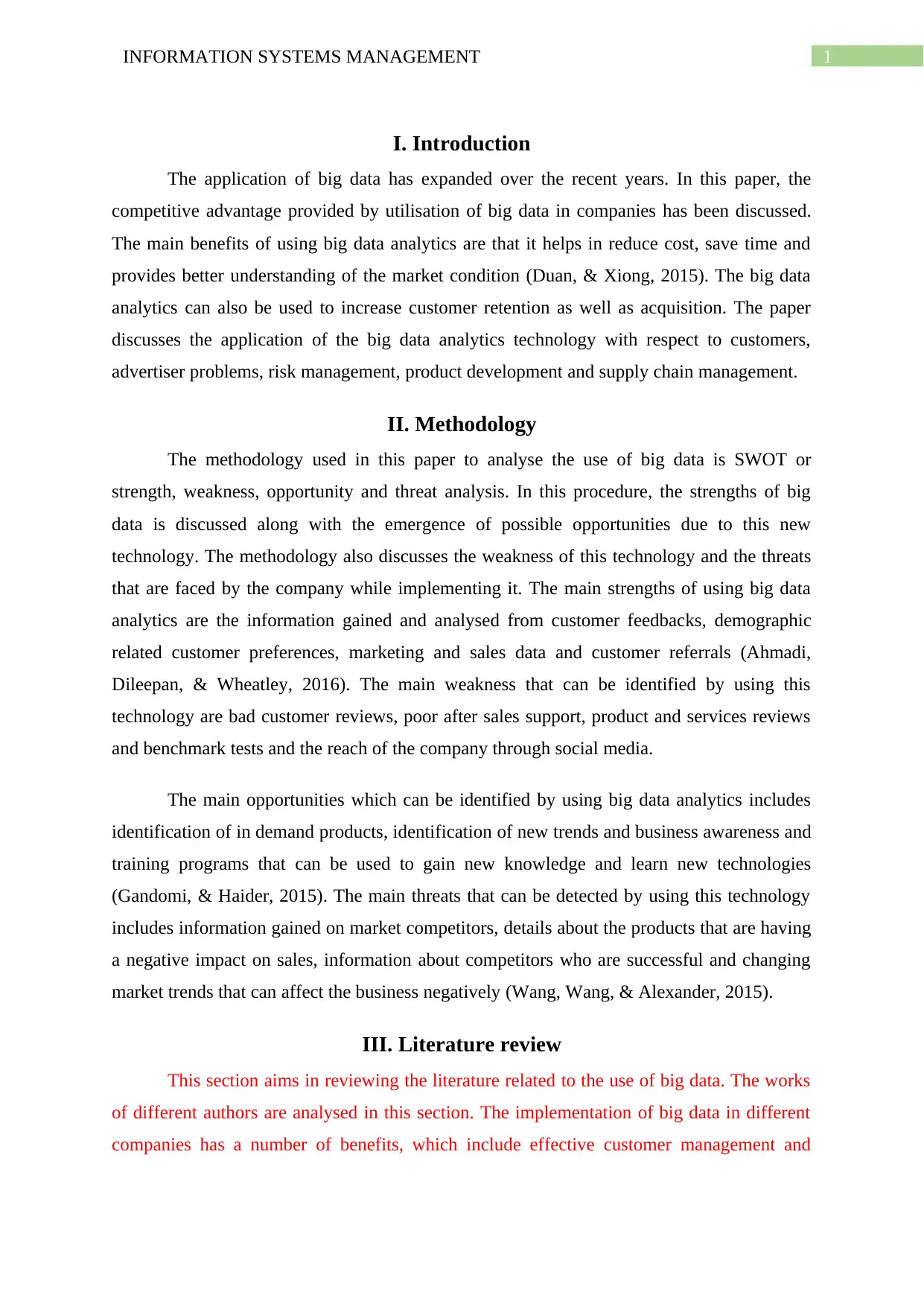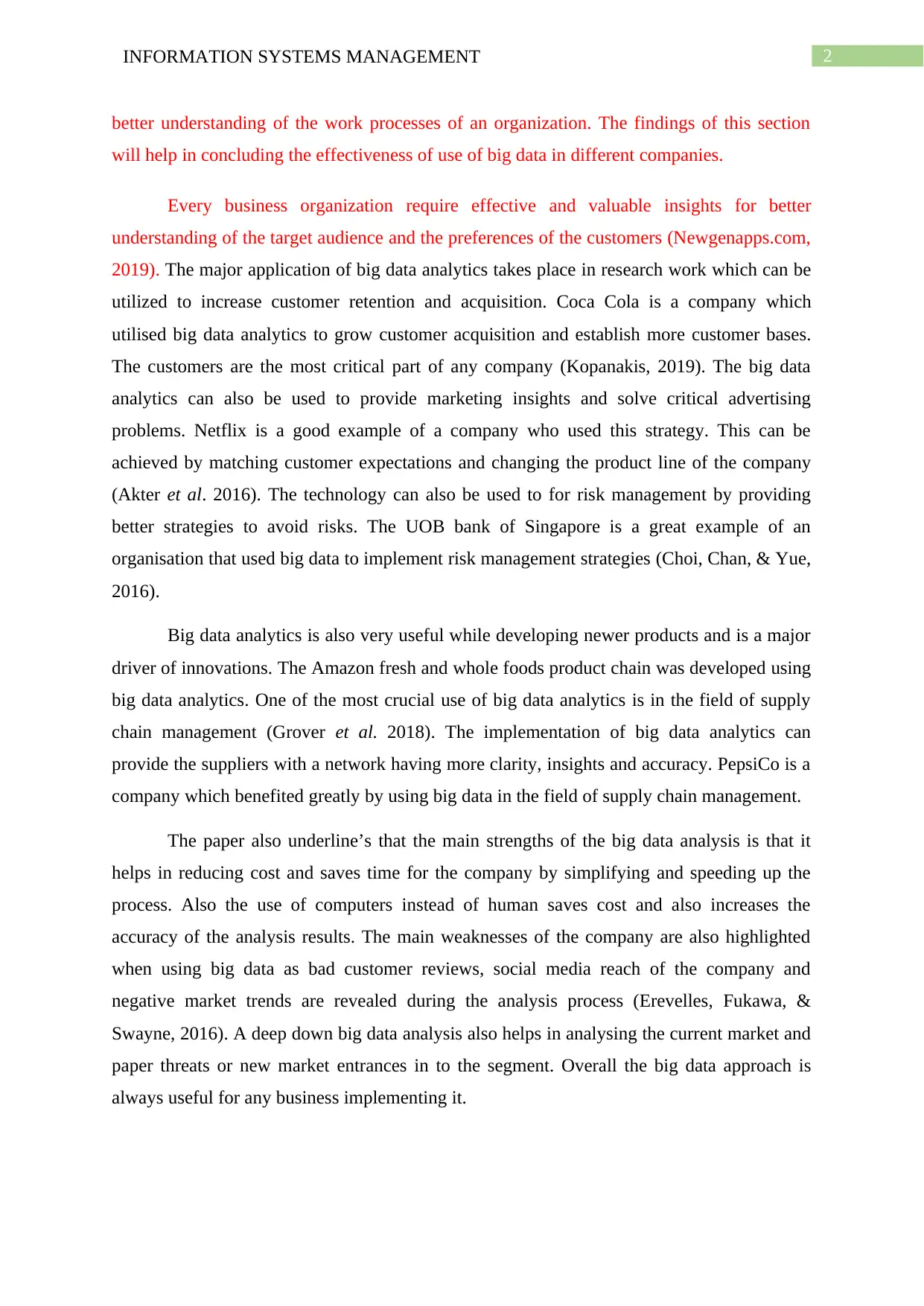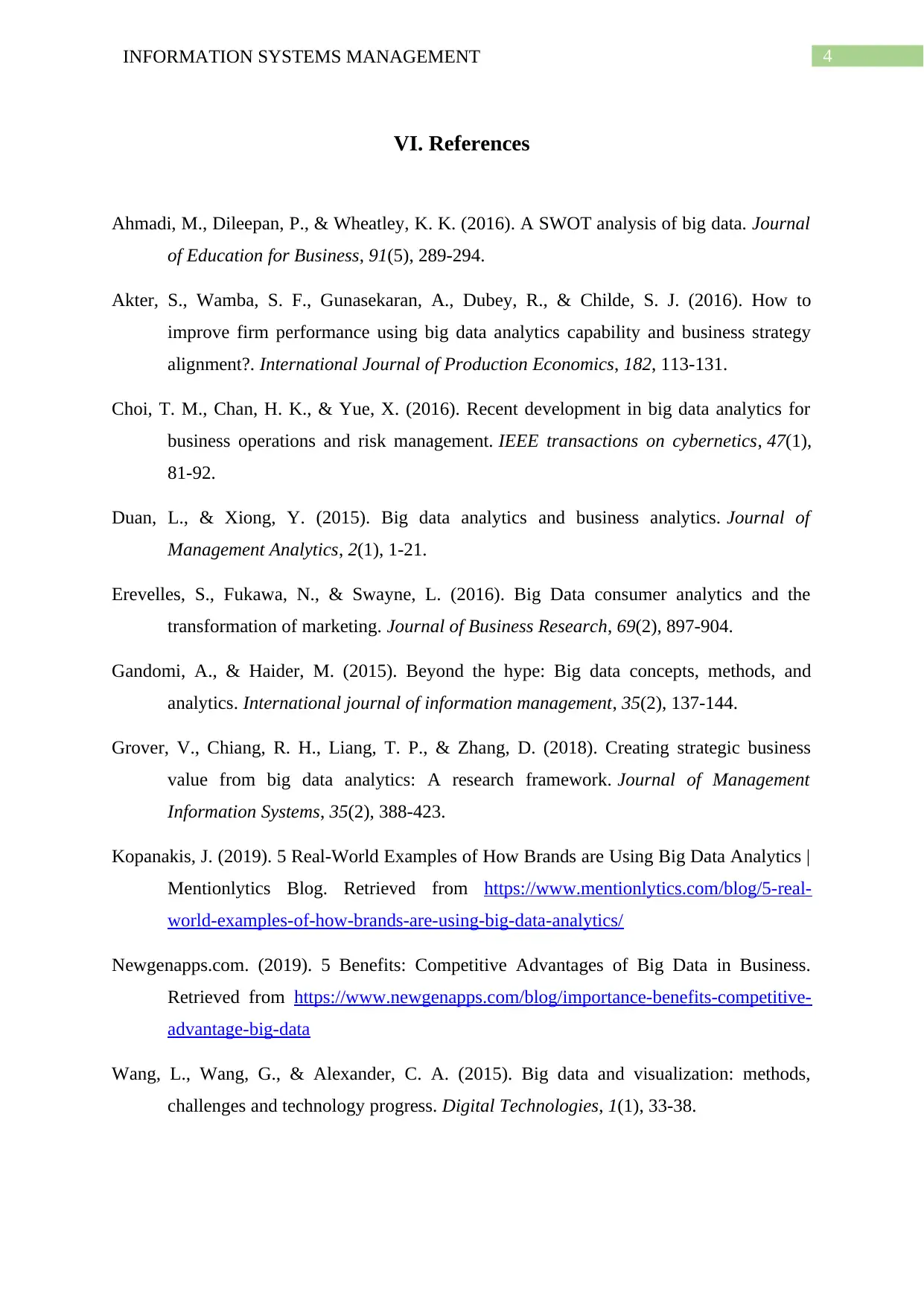Texas A&M: MIS - Big Data Analytics Competitive Advantage Report
VerifiedAdded on 2022/11/30
|5
|1375
|253
Report
AI Summary
This report examines the competitive advantages offered by the utilization of big data analytics in business. It begins with an introduction highlighting the benefits of big data, such as cost reduction, time savings, and improved market understanding, along with its application in customer management, advertising, risk management, product development, and supply chain management. The methodology employs a SWOT analysis to evaluate the strengths, weaknesses, opportunities, and threats associated with big data implementation. The literature review provides examples of companies like Coca-Cola, Netflix, UOB bank, Amazon, and PepsiCo that have leveraged big data for enhanced customer acquisition, marketing insights, risk management, product development, and supply chain optimization. The report concludes that big data analytics significantly improves competitive advantage and underscores the importance of addressing the associated threats to achieve organizational goals. References from various authors are provided to support the analysis.

Running head: INFORMATION SYSTEMS MANAGEMENT
INFORMATION SYSTEMS MANAGEMENT
Name of the Student:
Name of the University:
Author Note:
INFORMATION SYSTEMS MANAGEMENT
Name of the Student:
Name of the University:
Author Note:
Paraphrase This Document
Need a fresh take? Get an instant paraphrase of this document with our AI Paraphraser

1INFORMATION SYSTEMS MANAGEMENT
I. Introduction
The application of big data has expanded over the recent years. In this paper, the
competitive advantage provided by utilisation of big data in companies has been discussed.
The main benefits of using big data analytics are that it helps in reduce cost, save time and
provides better understanding of the market condition (Duan, & Xiong, 2015). The big data
analytics can also be used to increase customer retention as well as acquisition. The paper
discusses the application of the big data analytics technology with respect to customers,
advertiser problems, risk management, product development and supply chain management.
II. Methodology
The methodology used in this paper to analyse the use of big data is SWOT or
strength, weakness, opportunity and threat analysis. In this procedure, the strengths of big
data is discussed along with the emergence of possible opportunities due to this new
technology. The methodology also discusses the weakness of this technology and the threats
that are faced by the company while implementing it. The main strengths of using big data
analytics are the information gained and analysed from customer feedbacks, demographic
related customer preferences, marketing and sales data and customer referrals (Ahmadi,
Dileepan, & Wheatley, 2016). The main weakness that can be identified by using this
technology are bad customer reviews, poor after sales support, product and services reviews
and benchmark tests and the reach of the company through social media.
The main opportunities which can be identified by using big data analytics includes
identification of in demand products, identification of new trends and business awareness and
training programs that can be used to gain new knowledge and learn new technologies
(Gandomi, & Haider, 2015). The main threats that can be detected by using this technology
includes information gained on market competitors, details about the products that are having
a negative impact on sales, information about competitors who are successful and changing
market trends that can affect the business negatively (Wang, Wang, & Alexander, 2015).
III. Literature review
This section aims in reviewing the literature related to the use of big data. The works
of different authors are analysed in this section. The implementation of big data in different
companies has a number of benefits, which include effective customer management and
I. Introduction
The application of big data has expanded over the recent years. In this paper, the
competitive advantage provided by utilisation of big data in companies has been discussed.
The main benefits of using big data analytics are that it helps in reduce cost, save time and
provides better understanding of the market condition (Duan, & Xiong, 2015). The big data
analytics can also be used to increase customer retention as well as acquisition. The paper
discusses the application of the big data analytics technology with respect to customers,
advertiser problems, risk management, product development and supply chain management.
II. Methodology
The methodology used in this paper to analyse the use of big data is SWOT or
strength, weakness, opportunity and threat analysis. In this procedure, the strengths of big
data is discussed along with the emergence of possible opportunities due to this new
technology. The methodology also discusses the weakness of this technology and the threats
that are faced by the company while implementing it. The main strengths of using big data
analytics are the information gained and analysed from customer feedbacks, demographic
related customer preferences, marketing and sales data and customer referrals (Ahmadi,
Dileepan, & Wheatley, 2016). The main weakness that can be identified by using this
technology are bad customer reviews, poor after sales support, product and services reviews
and benchmark tests and the reach of the company through social media.
The main opportunities which can be identified by using big data analytics includes
identification of in demand products, identification of new trends and business awareness and
training programs that can be used to gain new knowledge and learn new technologies
(Gandomi, & Haider, 2015). The main threats that can be detected by using this technology
includes information gained on market competitors, details about the products that are having
a negative impact on sales, information about competitors who are successful and changing
market trends that can affect the business negatively (Wang, Wang, & Alexander, 2015).
III. Literature review
This section aims in reviewing the literature related to the use of big data. The works
of different authors are analysed in this section. The implementation of big data in different
companies has a number of benefits, which include effective customer management and

2INFORMATION SYSTEMS MANAGEMENT
better understanding of the work processes of an organization. The findings of this section
will help in concluding the effectiveness of use of big data in different companies.
Every business organization require effective and valuable insights for better
understanding of the target audience and the preferences of the customers (Newgenapps.com,
2019). The major application of big data analytics takes place in research work which can be
utilized to increase customer retention and acquisition. Coca Cola is a company which
utilised big data analytics to grow customer acquisition and establish more customer bases.
The customers are the most critical part of any company (Kopanakis, 2019). The big data
analytics can also be used to provide marketing insights and solve critical advertising
problems. Netflix is a good example of a company who used this strategy. This can be
achieved by matching customer expectations and changing the product line of the company
(Akter et al. 2016). The technology can also be used to for risk management by providing
better strategies to avoid risks. The UOB bank of Singapore is a great example of an
organisation that used big data to implement risk management strategies (Choi, Chan, & Yue,
2016).
Big data analytics is also very useful while developing newer products and is a major
driver of innovations. The Amazon fresh and whole foods product chain was developed using
big data analytics. One of the most crucial use of big data analytics is in the field of supply
chain management (Grover et al. 2018). The implementation of big data analytics can
provide the suppliers with a network having more clarity, insights and accuracy. PepsiCo is a
company which benefited greatly by using big data in the field of supply chain management.
The paper also underline’s that the main strengths of the big data analysis is that it
helps in reducing cost and saves time for the company by simplifying and speeding up the
process. Also the use of computers instead of human saves cost and also increases the
accuracy of the analysis results. The main weaknesses of the company are also highlighted
when using big data as bad customer reviews, social media reach of the company and
negative market trends are revealed during the analysis process (Erevelles, Fukawa, &
Swayne, 2016). A deep down big data analysis also helps in analysing the current market and
paper threats or new market entrances in to the segment. Overall the big data approach is
always useful for any business implementing it.
better understanding of the work processes of an organization. The findings of this section
will help in concluding the effectiveness of use of big data in different companies.
Every business organization require effective and valuable insights for better
understanding of the target audience and the preferences of the customers (Newgenapps.com,
2019). The major application of big data analytics takes place in research work which can be
utilized to increase customer retention and acquisition. Coca Cola is a company which
utilised big data analytics to grow customer acquisition and establish more customer bases.
The customers are the most critical part of any company (Kopanakis, 2019). The big data
analytics can also be used to provide marketing insights and solve critical advertising
problems. Netflix is a good example of a company who used this strategy. This can be
achieved by matching customer expectations and changing the product line of the company
(Akter et al. 2016). The technology can also be used to for risk management by providing
better strategies to avoid risks. The UOB bank of Singapore is a great example of an
organisation that used big data to implement risk management strategies (Choi, Chan, & Yue,
2016).
Big data analytics is also very useful while developing newer products and is a major
driver of innovations. The Amazon fresh and whole foods product chain was developed using
big data analytics. One of the most crucial use of big data analytics is in the field of supply
chain management (Grover et al. 2018). The implementation of big data analytics can
provide the suppliers with a network having more clarity, insights and accuracy. PepsiCo is a
company which benefited greatly by using big data in the field of supply chain management.
The paper also underline’s that the main strengths of the big data analysis is that it
helps in reducing cost and saves time for the company by simplifying and speeding up the
process. Also the use of computers instead of human saves cost and also increases the
accuracy of the analysis results. The main weaknesses of the company are also highlighted
when using big data as bad customer reviews, social media reach of the company and
negative market trends are revealed during the analysis process (Erevelles, Fukawa, &
Swayne, 2016). A deep down big data analysis also helps in analysing the current market and
paper threats or new market entrances in to the segment. Overall the big data approach is
always useful for any business implementing it.
⊘ This is a preview!⊘
Do you want full access?
Subscribe today to unlock all pages.

Trusted by 1+ million students worldwide

3INFORMATION SYSTEMS MANAGEMENT
V. Conclusion
Thus it can be concluded that big data analytics has significant role in improving the
business opportunities for different organization as it helps in improving the competitive
advantage in the market. Although the technology provides a number of benefits, the threats
linked with the technology are needed to be addressed. Effective use of big data analytics can
significantly help an organization to reach its goals and fulfil its objectives.
V. Conclusion
Thus it can be concluded that big data analytics has significant role in improving the
business opportunities for different organization as it helps in improving the competitive
advantage in the market. Although the technology provides a number of benefits, the threats
linked with the technology are needed to be addressed. Effective use of big data analytics can
significantly help an organization to reach its goals and fulfil its objectives.
Paraphrase This Document
Need a fresh take? Get an instant paraphrase of this document with our AI Paraphraser

4INFORMATION SYSTEMS MANAGEMENT
VI. References
Ahmadi, M., Dileepan, P., & Wheatley, K. K. (2016). A SWOT analysis of big data. Journal
of Education for Business, 91(5), 289-294.
Akter, S., Wamba, S. F., Gunasekaran, A., Dubey, R., & Childe, S. J. (2016). How to
improve firm performance using big data analytics capability and business strategy
alignment?. International Journal of Production Economics, 182, 113-131.
Choi, T. M., Chan, H. K., & Yue, X. (2016). Recent development in big data analytics for
business operations and risk management. IEEE transactions on cybernetics, 47(1),
81-92.
Duan, L., & Xiong, Y. (2015). Big data analytics and business analytics. Journal of
Management Analytics, 2(1), 1-21.
Erevelles, S., Fukawa, N., & Swayne, L. (2016). Big Data consumer analytics and the
transformation of marketing. Journal of Business Research, 69(2), 897-904.
Gandomi, A., & Haider, M. (2015). Beyond the hype: Big data concepts, methods, and
analytics. International journal of information management, 35(2), 137-144.
Grover, V., Chiang, R. H., Liang, T. P., & Zhang, D. (2018). Creating strategic business
value from big data analytics: A research framework. Journal of Management
Information Systems, 35(2), 388-423.
Kopanakis, J. (2019). 5 Real-World Examples of How Brands are Using Big Data Analytics |
Mentionlytics Blog. Retrieved from https://www.mentionlytics.com/blog/5-real-
world-examples-of-how-brands-are-using-big-data-analytics/
Newgenapps.com. (2019). 5 Benefits: Competitive Advantages of Big Data in Business.
Retrieved from https://www.newgenapps.com/blog/importance-benefits-competitive-
advantage-big-data
Wang, L., Wang, G., & Alexander, C. A. (2015). Big data and visualization: methods,
challenges and technology progress. Digital Technologies, 1(1), 33-38.
VI. References
Ahmadi, M., Dileepan, P., & Wheatley, K. K. (2016). A SWOT analysis of big data. Journal
of Education for Business, 91(5), 289-294.
Akter, S., Wamba, S. F., Gunasekaran, A., Dubey, R., & Childe, S. J. (2016). How to
improve firm performance using big data analytics capability and business strategy
alignment?. International Journal of Production Economics, 182, 113-131.
Choi, T. M., Chan, H. K., & Yue, X. (2016). Recent development in big data analytics for
business operations and risk management. IEEE transactions on cybernetics, 47(1),
81-92.
Duan, L., & Xiong, Y. (2015). Big data analytics and business analytics. Journal of
Management Analytics, 2(1), 1-21.
Erevelles, S., Fukawa, N., & Swayne, L. (2016). Big Data consumer analytics and the
transformation of marketing. Journal of Business Research, 69(2), 897-904.
Gandomi, A., & Haider, M. (2015). Beyond the hype: Big data concepts, methods, and
analytics. International journal of information management, 35(2), 137-144.
Grover, V., Chiang, R. H., Liang, T. P., & Zhang, D. (2018). Creating strategic business
value from big data analytics: A research framework. Journal of Management
Information Systems, 35(2), 388-423.
Kopanakis, J. (2019). 5 Real-World Examples of How Brands are Using Big Data Analytics |
Mentionlytics Blog. Retrieved from https://www.mentionlytics.com/blog/5-real-
world-examples-of-how-brands-are-using-big-data-analytics/
Newgenapps.com. (2019). 5 Benefits: Competitive Advantages of Big Data in Business.
Retrieved from https://www.newgenapps.com/blog/importance-benefits-competitive-
advantage-big-data
Wang, L., Wang, G., & Alexander, C. A. (2015). Big data and visualization: methods,
challenges and technology progress. Digital Technologies, 1(1), 33-38.
1 out of 5
Related Documents
Your All-in-One AI-Powered Toolkit for Academic Success.
+13062052269
info@desklib.com
Available 24*7 on WhatsApp / Email
![[object Object]](/_next/static/media/star-bottom.7253800d.svg)
Unlock your academic potential
Copyright © 2020–2025 A2Z Services. All Rights Reserved. Developed and managed by ZUCOL.




